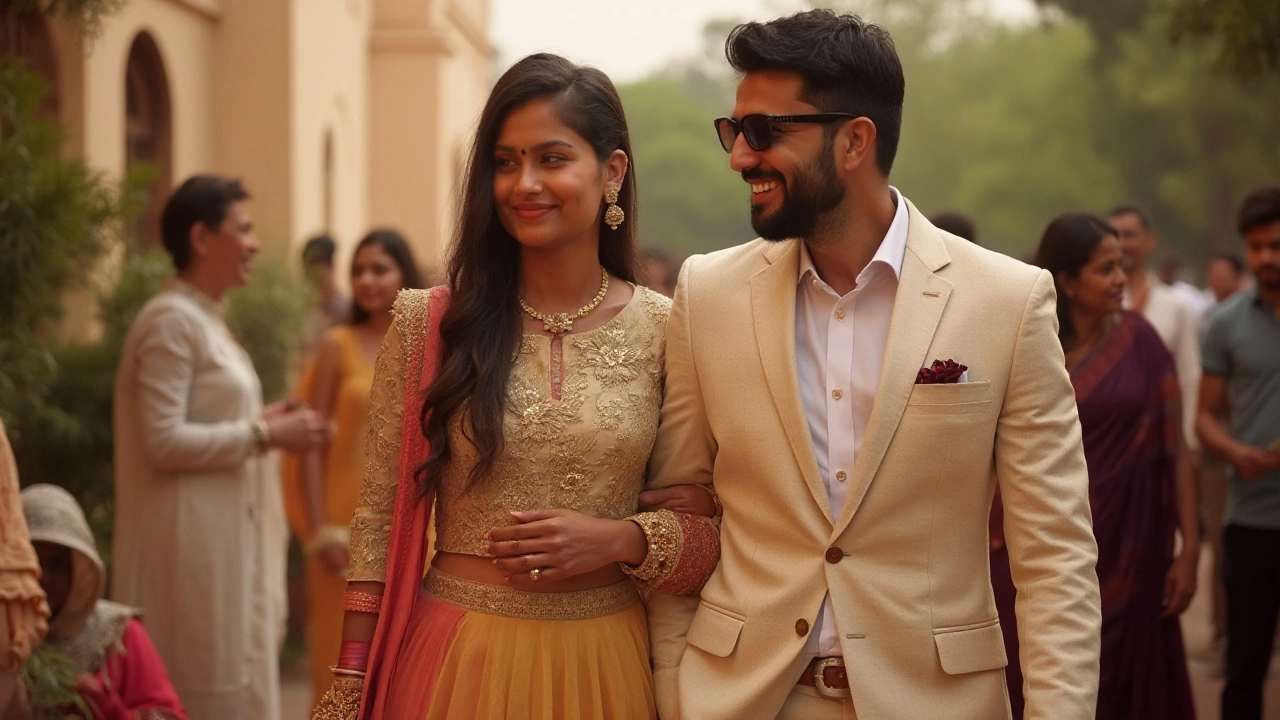Stepping into the world of men's fashion, especially when it comes to suits, can feel like walking through an art gallery where the masterpieces are meant to be worn. The elegance and sophistication of a well-tailored suit is undeniable, but how do you find one that suits you best? It’s easier than you might think, once you know what to look for.
Whether you’re a seasoned suit wearer or a newcomer to the scene, understanding the basics of your body shape and fit can set you on the right path. The right suit doesn't just fit; it complements your shape and personal style, making a statement all on its own.
From selecting appropriate fabrics to knowing when and how a suit needs tailoring, each step plays a critical role in achieving that perfect look. So let’s dive in and explore what makes a suit truly shine on you.
- Understanding Your Body Type
- Choosing the Right Fabric
- The Importance of Fit
- Exploring Styles and Cuts
- Accessorizing Your Suit
- Tailoring Tips for the Perfect Fit
Understanding Your Body Type
When it comes to finding the perfect men's suit, understanding your body type is the vital first step. Every man has a unique physique, and no two body shapes are same. Each deserves a specific approach. Knowing whether you're a tall rectangle, a broad square, or a lithe trapezoid can guide you towards a suit that not only fits but also flatters. The cut of a suit can emphasize your best features or help balance proportions, so it’s worth taking some time to consider what works best for you.
The process begins by taking a good look at yourself in the mirror, possibly with a measuring tape in hand. Are your shoulders broad or narrow? Is your torso longer than your legs? By answering these questions, you begin to categorize your shape. One classic fit might be the male 'inverted triangle,' where the shoulders are the broadest part. Such shapes benefit from single-breasted jackets with structured shoulders and tapered trousers to accentuate that V-shape. If you find you’re more of a rectangle with equal shoulder-hip width, a two-button jacket adds dimension to your physique.
For those who are on the shorter side, vertical stripes can provide the illusion of height. Larger men might prefer dark, matte fabrics that don’t reflect light as much, creating a slimming effect. Conversely, if you possess an elongated frame, consider jackets with a slight reach at the hip level to break up the vertical stretch. It’s all about the details; for instance, small checks and patterns can enhance an otherwise slim physique without overwhelming it. Remember, the suit should shape you, not the other way around.
"A suit is not merely garments tailored to follow a man’s frame, but it is a narrative of character and style," notes renowned fashion critic Virgil Tesla.
The nuances of a perfect suit also rest in the fabric's weft and weave, which can accommodate different shapes. Wool is a favorite due to its versatility, while linen or lighter cotton suits might best serve warmer climates or more casual settings. It is essential to align the fabric and style with not only your body shape but the context you’re dressing for — whether it's a boardroom, wedding, or evening out. By matching the fabric weight with your needs, you enhance both comfort and silhouette.
Understanding one's body type isn’t just about the measurements; it’s about how these numbers translate into style. Choosing the right suit fitting, in tandem with fabric choice, makes all the difference. A noteworthy tip: try the suit on before any purchase. The mirror will be your best stylist, so trust what it reflects. Keep an open mind and remember that a perfectly matched suit is more than just a uniform. It's a declaration of who you are.
Choosing the Right Fabric
When it comes to selecting a men's suit, the fabric is just as significant as the cut. The material you choose not only affects the look and feel of the suit but also its durability and suitability for different occasions and climates. One of the most prevalent fabrics is wool, known for its versatility and classic appeal. Wool suits are breathable, offering comfort across a range of temperatures, which is why they are often considered the best choice for year-round wear.
However, not all wool fabric is the same. There are variations such as worsted wool, which offers a smooth and durable choice for a sharp look, or tweed, which is heavier and typically more suitable for colder weather. For warmer climates, linen or cotton might be preferable due to their light weight and airy nature, although they do tend to wrinkle easily. These qualities can lend themselves to a more casual vibe, making them ideal for less formal settings or summer events.
It's important to note the rise of blended fabrics, which combine the positive attributes of multiple materials, thus enhancing durability or comfort. A cotton-polyester blend, for instance, retains its shape better and resists wrinkles more effectively than pure cotton. Blends are often more affordable, too, without sacrificing style. The trick is knowing which combination guarantees the advantages you desire while ensuring the fit remains luxurious and upscale.
"The quality of a suit fabric directly translates into how it drapes, feels, and ultimately performs," says renowned fashion consultant Felix Valiant. "Investing in good-quality fabric is investing in the longevity of your wardrobe."
For those aiming to make a sustainable choice, fabrics such as recycled polyester or organic cotton are becoming popular. They provide balance in quality with an eco-friendly footprint. It's increasingly important to consider the environmental impact of the textiles you embrace. If sustainability is paramount, look for designers establishing themselves as frontrunners in eco-friendly men's fashion.
A common question involves what patterns might best serve a professional environment. Pinstripes convey power and formality, ideal for the boardroom, while plaid or check patterns offer a bit more flair, which can be just right for networking events or smart-casual affairs. Ultimately, the fabric you select serves as the literal and figurative groundwork of your sartorial expression.

The Importance of Fit
The fit of a suit often determines its impact and how it makes you feel when striding into a room. Much like the perfectly timed crescendo in an orchestrated symphony, the right fit can lift your confidence and present your personality with eloquence. Many men, charmed by labels and price tags, often ignore this pivotal aspect, causing them to feel out of place in clothes that don't reflect their stature. The aim is always to choose a suit that follows the natural contours of your body, enhancing your best features and camouflaging any you'd rather not highlight.
Let's delve deeper into why fit holds such gravity in the realm of men's attire. A suit that fits well draws attention to your posture, firstly. A well-fitted jacket will frame your shoulders snugly, elevating a regal and stately look. According to GQ magazine, “A poor fit will drown your frame or constrict it, neither of which are flattering.” This quote underlines how imperative it is for men to prioritize the cut of their suits. Additionally, a suit with the correct fit provides comfort, essential for long office hours or wedding receptions, allowing a gentleman to enjoy their environment without constantly adjusting their clothing.
The Jacket Fit
Begin with the shoulders, as they serve as the foundation of a jacket. Ensure there is no gap between your shoulders and the seam of the jacket, avoiding any unnecessary creases. A seamless line is the goal. Next, turn your attention to the chest and torso. The fabric should sit comfortably, neither pulled tight nor loose. A simple test is to button the middle button—if you notice a strain, consider a larger size or a different cut. The jacket length too is crucial; it should cover your rear while remaining no longer than the midpoint of your palm. This length maintains balance within your overall appearance.
The Trouser Fit
While many emphasize the jacket, trousers deserve equal attention. The waistband should rest naturally on your hips without needing a belt to hold them in place. A belt is an accessory, not an essential in holding your trousers up. Look for a clean break at the ankle—anything more, or less, might disrupt the line of your suit. A slight break where the trousers rest on the shoe emphasizes elegance, offering ease of movement and visual interest. Remember, a fit tailored to your bodily proportions leaves a lasting impression on both the wearer and those who share the room with them.
Lastly, let's not underestimate the role of alterations. Tailoring transforms an off-the-rack suit into a masterpiece custom-designed for your silhouette. Investing in minor adjustments can make a marked difference, as even minor tweaks can vastly adjust the fit and feel of a suit. Discuss with a professional tailor on how to achieve the desired fit, focusing on those key areas that need refinement for that polished look.
Exploring Styles and Cuts
When it comes to choosing a suit, the style and cut are not just about what's fashionable; they are about what flatters your form and reflects your personality. There is a spectrum of options when it comes to men's suits, from traditional to modern, each offering unique characteristics that can pave the way to various fashion statements. For instance, the classic American style—also known as the Sack suit—features a more relaxed fit, making it versatile and a staple for many wardrobes. This style is known for its minimal shoulder padding and boxy silhouette, making it a comfortable option for those who prefer ease of movement and a more laid-back aesthetic.
On the other end of the spectrum is the European cut, specifically the Italian style, renowned for its sleek, close-to-the-body fit. It's everything but forgiving, designed to highlight the wearer's build. This style is often chosen by those with a more athletic build who wish to accentuate their frame. The Italian suit often features elements such as padded shoulders and a tighter waist, creating a sharp, commanding presence. As Tom Ford once said,
“Dressing well is a form of good manners.”Choosing an Italian cut almost guarantees you stand out in a crowd where attention to detail is tantamount.
A popular middle-ground that balances the extremes is the British cut, characterized by its structured lines and elegant drape. It typically sports a double-breasted design, lightly padded shoulders, and tapered trousers. The British style epitomizes sophistication with its timeless appeal, often favored for formal events where tradition speaks volumes. As you explore these different styles, remember that the suit you wear should be an extension of who you are, resonating both with your physical characteristics and your personal essence.
The Rise of Modern Fit
In recent years, a new contender has walked into the sartorial arena—the modern fit. It's an adaptation that marries traditional tailoring with contemporary flair. This style offers a tailored look that isn't too tight, striking the perfect balance between comfort and style. A modern fit is suitable for a variety of body types, providing versatility without sacrificing fashion-forward elegance. Men’s suits in modern cuts are often designed with subtle tapering at the waist and slimmer pant legs, accommodating both professional and casual aesthetics. According to recent fashion reports, the demand for modern-fit suits has surged by almost 25% in the past decade, reflecting a shift towards comfort-driven elegance in men’s fashion.
When evaluating different styles and cuts, consider how each element aligns with your personal style story. Whether your approach is to play it safe with a traditional cut or to express a bold personality with a sleeker design, there are endless ways to explore the fascinating world of menswear. So, before you make your decision, delve into these styles and take your time, perhaps visiting a few boutiques or speaking with a designer to understand and appreciate the nuance. After all, a suit fitting like a second skin is what you ideally aim for, transforming fabric and thread into an extension of yourself.

Accessorizing Your Suit
Dressing up in a suit is an art, and accessorizing it adds the subtle brush strokes that complete the masterpiece. The right accessories can elevate your look from basic to debonair, showing attention to detail and a personal flair. One of the most essential accessories, the necktie or bow tie, creates a focal point that often sets the tone of your attire. Opt for silk if you're aiming for elegance, while wool or cotton brings a touch of casual chic. Remember, your tie should complement, not match, the color of your suit. A patterned tie on a solid suit can add depth and dimension to your ensemble, whereas a solid tie might work wonders with a pinstripe or checkered suit.
The perfect pocket square is another accessory that adds a hint of sophistication to your look. It's not merely a functional piece but a statement of style, and the choices are endless. You can go classic with white linen or add a pop of color to draw the eye. The key is to ensure it doesn't match your tie exactly—instead, aim for a harmonious blend of colors and patterns. Depending on the occasion, you could go for a presidential fold for formal events or a puff fold for a more relaxed gathering.
When it comes to footwear, your choice should seamlessly integrate with your men's suit. A pair of polished brogues or oxfords often does the trick, lending an air of authority and elegance. Brown works incredibly well with navy, whereas black shoes are the quintessential choice for charcoal or black suits. Socks should be seen as an accessory too—traditional wisdom would argue for them to match your trousers, but a splash of color can add an unexpected twist.
Strong accessories speak volumes, and nothing is stronger than a well-chosen watch or set of cufflinks. These are quintessential reflections of your personal style. Watches are often considered one of the few pieces of jewelry a man can wear unabashedly; going vintage or sleek and modern can say a lot about who you are. Cufflinks, on the other hand, are subtle yet effective in adding luxury, whether through intricate designs or precious metals.
"Style is the perfection of a point of view," said Richard Eberhart. A carefully curated ensemble tells others what yours is.
Belts are both practical and fashionable; choosing the right one can add that final touch to a well-coordinated look. It should be high-quality leather, ideally in a color that matches your shoes. Reversible belts offer flexibility, and can save you time if you're switching between looks. Don't overlook tie bars and lapel pins, subtle additions that convey tastefulness and individuality. They shouldn't compete with your standout pieces but share the stage harmoniously.
Tailoring Tips for the Perfect Fit
Finding that ideal suit is akin to stumbling across a rare gem – the cut, the style, and most importantly, the fit. It’s the fit that often dictates whether the suit will look just good or absolutely stunning on you. Tailored suits are no longer a luxury reserved only for the affluent; with the right knowledge, anyone can achieve that perfect bespoke look without breaking the bank. One of the key secrets of bespoke tailoring lies in understanding your body's unique dimensions and how to make the most of them. Did you know that a well-fitted suit can actually make you look taller, more athletic, and well-proportioned? The magic begins with the basics: the shoulders. Ensure the suit jacket's shoulders hug your own without any overhang; this is non-negotiable since altering shoulders can be both complicated and expensive.
Next on the checklist are the suit's sleeves and pant legs. A common mistake many make is not paying enough attention to sleeve and pant lengths. Ideally, jacket sleeves should end just above the wrist bone, allowing for about half an inch of your shirt cuff to show. This small detail, though often overlooked, adds an impeccable finish to your overall look. Similarly, pants should either slightly break over the top of your shoes or touch the ground without pooling at the ankles. This is not only aesthetically pleasing but also projects a tidy, well-groomed appearance. When it comes to making adjustments, the waist area of both the jacket and pants is critical. A nipped-in jacket waist can drastically improve your silhouette, while pants should sit comfortably on your hips without being too snug or too loose.
Now, here’s an insider tip: Always befriend a skilled tailor. This relationship is as crucial as the suit itself. Frances Card, a renowned fashion consultant, once stated,
“A good tailor is a man's best friend. They can transform an off-the-rack ensemble into something remarkable, tailored to your exact needs.”With the guidance of a seasoned tailor, alterations that might seem tricky, such as adjusting lapel widths or changing the jacket vent style, become feasible without compromising the suit's integrity. Furthermore, while it might seem tempting to skimp on tailoring costs, remember that the precision involved in tailoring can make even the most affordable suits look extravagant.
Let’s not forget about fabric choice – it’s an oft-overlooked aspect when people consider tailoring. While most folks might solely focus on the color and pattern, true suit aficionados understand the importance of fabric weight and weave. Light wool is perfect for warmer climates and offers comfort without sacrificing style, making it a smart choice for a fashion-forward look. Think about including breathable fabrics like linen for those warm summer events or opting for heavier tweeds in winter. The type of fabric affects how a suit drapes and fits once tailored, making it paramount to choose wisely. When personal fit is your mission, fabric choice is a friend, guiding you closer to that impeccable suite fit.
